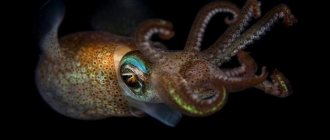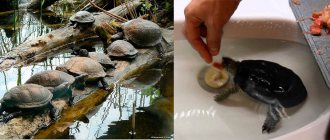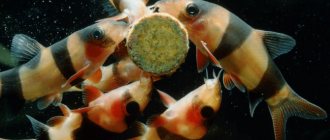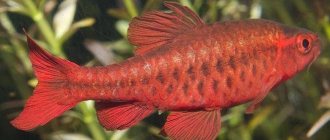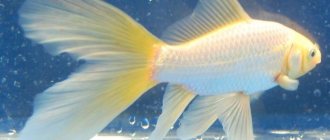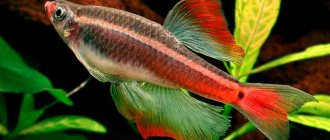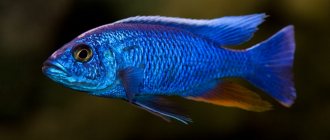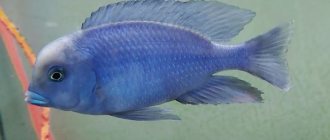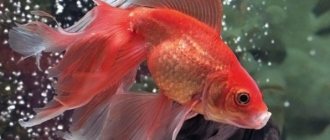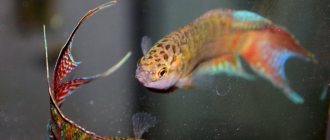Ocellated astronotus or Oscar (lat. Astronotus ocellatus, English oscar fish) is a large and brightly colored freshwater cichlid from South America. One of the most popular aquarium fish of the cichlid family. This is a large, aggressive, but very smart fish. From the article you will learn what types of astronotus there are, how to keep an Oscar, feed it, choose aquarium mates and breed it.
Origin and description
Astronotus
lives in the Amazon River basin and in the upper tributaries of the Paraguay and Paran. It was first brought to our country 60 years ago. Despite its impressive size, this fish arouses wild interest and great love among many aquarists.
The body shape of the astronotus is elongated in length and flattened on the sides. The head is large with a convex forehead and large expressive eyes.
The fish has large, rounded dorsal and anal fins. At the moment, many multi-colored variations of astronotus have been created. The most common in aquariums are: natural color, copper and albino variant with a milky white background and a red pattern on it. Sexual differences in males and females are not pronounced.
They become noticeable only during the spawning period. During this period, the female has a large ovipositor, and the males have a small vas deferens. In nature, astronotus can grow up to 40 cm in length. In this case, body weight can reach 2 kg. In aquariums they grow no more than 25 cm. Life expectancy is quite high; under good conditions, astronotus can live in an aquarium for up to 20 years. During this time, he becomes not just a beloved pet, but a real member of the family!
Where does the Ocellated Astronotus live?
Photo: Ocellated astronotus fish
In nature, representatives of this species can be found in South America; their range is quite wide and includes:
- Venezuela;
- Guiana;
- Brazil;
- Paraguay;
- Uruguay;
- Argentina.
Thus, the range of this fish includes half of the continent, or even more. It feels especially good in the basins of rivers such as the Orinoco, Amazon, Rio Negro and Parana. The fish feels good not only in its native places, it acclimatizes easily. So, it was brought to the USA, Australia and China, and in all these countries it has successfully reproduced and thrives in the natural environment, even some local species of small fish suffer from it. It also breeds well in captivity, as a result of which Astronotus are kept in aquariums all over the world.
In nature, you can most often find it in rivers, but it is also found in flowing lakes and canals. Prefers places with a sandy or muddy bottom. They love dark water: in South America, in their habitats, it is very clean and soft, dark amber in color, and when viewed from above it seems almost black.
Interesting fact: The activity of Astronotus can take you by surprise - don’t try too hard and create a unique internal design of the aquarium in which this fish will live, because it will certainly turn everything upside down. If you choose decorations, they should be large so that they are difficult to move.
Plants will also have a hard time: astronotuses will eat them and tear them off, or even dig them up, so they won’t live long. It is worth choosing strong equipment and trying to cover it.
Appearance
Astronotus is a large cichlid, in nature growing up to 45 cm (and weighing up to 1.5 kg). The size of aquarium specimens depends on the volume in which they are kept, but is usually a little more modest - 25-30 cm.
The fish has an oval, laterally compressed body. The fins are large, somewhat elongated. The anal and dorsal fin are practically connected to the tail, creating a kind of “fan”. The caudal fin is rounded.
The head is large, pointed, the forehead line is convex. The mouth is terminal, the lips are fleshy, and there are small teeth in the mouth. All these signs give us a typical predator.
The main body color is dark, almost black, with unevenly distributed red-orange spots. Sometimes they are arranged in almost vertical lines, reminiscent of the color of a tiger, which is why the fish got one of its names. At the base of the tail there is a black spot bordered by an orange stripe.
Interestingly, juvenile astronotus differ significantly in color from adults. Their spots are not red-orange, but white. These contrasting colors look very attractive. Sexual dimorphism is not expressed. Nowadays, several breeding forms have been obtained that differ in color and body shape.
Astronotuses are long-lived aquarium plants. In suitable conditions, fish can live up to 15 years.
Conditions of detention
If an astronotus lives in your house, keeping the pond clean is quite difficult. A purchased external biofilter will be a good helper for you. It will successfully clean the aquarium of ammonia that accumulates in the water, and also a large catfish that will happily feast on the leftover food of its neighbors. Astronotuses are very sensitive to lack of oxygen, so pay special attention to aeration and water filtration.
It is enough to change a third of the water once a week to keep your fish in good health. Astronotuses do not tolerate cold water well. To prevent your pets from getting sick, maintain the water temperature in the aquarium within 23 -27°C.
Feed your cichlids pieces of live or frozen fish or small live fish a couple of times a day. Astronotus is a big eater and, in order not to overfeed it, give it as much food as it can eat in two minutes. You can even arrange fasting days. Like all predators, astronotus like raw meat, beef liver and heart.
They eat squid, tadpoles and snails, earthworms, as well as bloodworms, flies and grasshoppers. If you do not have the opportunity to purchase animal food, you can feed astronotus with special food for cyclids. Some fish lovers prepare food for future use and store it chopped in the freezer.
Feeding the Astronotus
The natural diet of astronotus includes small fish, insects, worms, and algae. This species is a predator, so the fish must be fed a large amount of high-quality animal proteins.
Among aquarists, it is often practiced to feed astronotus with fish, ground beef, earthworms, and even dry cat food. It is strictly not recommended to feed Oscars meat from warm-blooded animals (beef). This is due to the fact that fish do not have suitable enzymes to digest these meat products. This practice also leads to obesity and degeneration of internal organs. Any invertebrates caught in nature (earthworms, crickets) can pose a risk of infecting your fish with infections and parasites. They also pollute the aquarium heavily, which can be dangerous when keeping fish of this size. Finally, all of these foods are exclusively protein foods and do not take into account the fish’s need for other nutrients.
Therefore, when feeding astronotus, it is better to focus on high-quality dry food for cichlids, for example, the Tetra Cichlid line.
The advantage of these feeds is obvious: they are rich in high-quality proteins, fully balanced, and contain essential vitamins and minerals. At the same time, they are absolutely safe, convenient to store and give to fish.
The food is selected depending on the size of the fish.
Tetra Cichlid (XL) Sticks are ideal food for adult Astronotus. The sticks float on the surface of the water and, due to their shape, take the form of natural food for large fish, while fully meeting the needs of the cichlid body for protein consumption.
To enhance the color of bright spots on the body of the fish, you can use Tetra Cichlid Color food in the form of balls with a concentrate of natural carotenoids.
For small astronotuses, we recommend small Tetra Cichlid Granules or Tetra Cichlid XL Flakes for all types of cichlids.
Astronotuses are prone to overeating, so once a week the fish need a “fasting” day.
Sex differences
It is quite difficult to distinguish a male from a female. However, males are larger than females, have longer and more pointed fins, and the eye spot at the base of the tail is more clearly defined. Females tend to have brighter colors. Clear differences appear during spawning: males develop a cone-shaped vas deferens; females have a trapezoidal ovipositor. Keeping astronotuses is not that difficult, the main thing is to provide the individuals with sufficient space with good quality water; and of course, choose your neighbors wisely. But in return you will get smart and beautiful fish.
Interesting Facts
- The now popular inhabitant of aquariums, Astronotus, was brought to European countries relatively recently, in 1934. And only after more than 20 years did these creatures end up in Russia.
- In the USA, astronotuses are used as an object for sport fishing and farms are created to grow them.
- Astronotus are supplied to our markets from fish-farming forms in Brazil, Thailand and Guinea.
- Astronotuses are considered quite intelligent creatures. They can be trained to eat food from their owner's hands. But when trying to get the astronotus, the fish may bite.
Breeding
To breed Astrontus, a group of 4-5 young fish is placed in a separate aquarium.
They form pairs, and the best one is taken to spawn. Astronotuses become sexually mature at 2 years of age. It must be taken into account that, despite their size, these fish are shy; they react cowardly to noise, which should not occur during the spawning period. It should take place in another spawning aquarium, since the neighbors will create unnecessary noise and a threat to the offspring of Astronotus. The aquarium must be equipped with aeration and filters. The water in it should be at a temperature of 26-28 degrees, soft. Soil in the spawning tank is not required. You can limit yourself to only a large and flat stone, where the female Astronotus will lay eggs. It should be noted that during spawning the fish change color. Males become very careful, carefully cleaning the surface of the stone. Only after this does spawning begin, lasting 4-5 hours. The female lays about 1000 eggs at a time. Astronotus are prolific fish. Producers carefully care for the offspring (eggs). They fan them with their fins, and simply guard the larvae. A week passes between the transformation of larvae into fry. The young begin to feed on their own.
For the first days, it is recommended to feed it with daphnia and brine shrimp, and then add chopped tubifex to the food. The fry of this fish grow unevenly. For this reason, it is better to sort them. At the age of one month, the size of the fry reaches 2 centimeters.
Natural enemies of ocellated astronotus
Photo: What an ocellated astronotus looks like
Among the predators, they are hunted by larger fish and birds. Astronotuses are not very fast and therefore become easy prey for many of these predators - it is extremely difficult for them to escape. Therefore, most of these fish die in the mouths of larger aquatic predators.
A somewhat smaller number, but still quite a lot, become victims of birds, and even less often they are disturbed by cats who decide to fish near the shore. People are of little concern to ocellated astronotus: they are rarely caught for breeding, since there are already enough in captivity that they are only caught as bycatch.
These fish can also quarrel with each other, and quite fiercely. Most often, during fights, they defend their right to territory. These fish can be reconciled by adding another inhabitant to the aquarium, equal in size or even larger than them: then the astronotuses become much more peaceful.
This fish has a good immune system, so they become infected relatively rarely. Diseases can be caused by infections or parasites. To avoid these misfortunes, you just need to take good care of your fish and not feed them dangerous food.
Immediately after acquisition, they need to be kept in quarantine and monitored. Astronotuses often get sick due to improper maintenance. For example, if a fish lacks vitamins or swims in stagnant water, it may develop hexamitosis.
Compatibility
Maybe someone will object: “How can this be? I have five asters living with other cichlids, and even with Pterygoplichts!?” Yes, of course, you can add large members of the family or other fish to astronotuses that will not allow themselves to be offended. But in this case, you must be prepared for the fact that at one point fights will break out. As a rule, this moment occurs during puberty and during spawning. Astronotus are very aggressive fish. Their temperament and their temperament do not allow them to be kept with other fish. Moreover, they exhibit intraspecific aggression. Therefore, the correct recommendation would be to keep a pair of astronotuses in a separate species aquarium.
Certainly astronotuses are not compatible with small and medium-sized fish. They perceive goldfish as an aperitif snack.
Speaking of compatibility, it should also be said that keeping astronotuses, even with the most rigid-leaved plants, is problematic. As a recommendation, we can advise decorating the aquarium with Anubias , Cryptocorynes , Echinodorus .
Habitat in nature
The natural habitat of all representatives of this species is water bodies in Brazil, as well as Venezuela, Guiana and Paraguay. Astronotus were first brought to Europe almost a century ago, and in Russia such fish appeared a little later, but almost immediately became incredibly popular among aquarists.
It should be noted that the ornamental fish is very successfully acclimatized in the southern part of America, where it is a popular object of widespread sport fishing. Almost all large farms specializing in breeding various types of ornamental fish are closely involved in breeding astronotus, especially such a popular variety as the “red Oscar”.
Varieties
Astronotus is divided into species, among which there are three main ones: tiger, red astronotus and albino species. Based on these main types, new species still appear through crossing, such as lemon, golden and yellow astronotuses. The albino species is also the result of breeding work.
Astronotus has a brindle coloration with crimson or orange spots on a gray body. An albino has red eyes against a white body with red patches.
The breeding work called “astronotus red oscar” is distinguished by its unusual brick-colored body with black fins and is considered one of the most beautiful color variations of astronotus. The red oscar has become famous for its rich red color and this species looks impressive in the aquarium, swimming majestically in it.
The veiled astronotus, which has long beautiful fins, has an unusual and attractive appearance. As a result of breeding work, new breeds were developed, such as the blue and walnut Oscar.
Diseases
Despite good health and resistance to diseases, one should be careful and prevent diseases by treating them at an early stage of development. The most dangerous are considered to be infectious diseases such as hexamitosis, accompanied by ulcers on the body and head of the fish. As well as other viral, fungal and parasitic diseases. In such cases, the fish is transplanted into an isolation ward and undergoes treatment, and the common aquarium with decorations is thoroughly disinfected.
Diseases such as obesity, lack of vitamins, gas embolism and stress are considered non-contagious.
